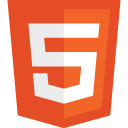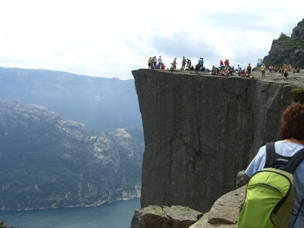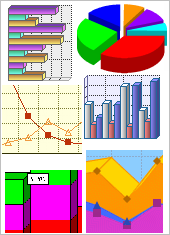HTML Images
 |
Always specify image size. If the size is unknown, the page will flicker
while the image loads.
|
HTML Images Syntax
In HTML, images are defined with the <img> tag.
The <img> tag is empty, it contains attributes only, and does not
have a closing tag.
The src attribute defines the url
(web address) of the image:
<img src="url" alt="some_text">
The alt Attribute
The alt attribute specifies an alternate text for the image, if it cannot
be displayed.
The value of the alt attribute should describe the image in words:
Example
<img src="html5.gif" alt="The
official HTML5 Icon">
The alt attribute is required. A web page will not validate
correctly without it.
HTML Screen Readers
Screen readers are software programs that can read what is displayed on
a screen.
Used on the web, screen readers can "reproduce" HTML as text-to-speech, sound
icons, or braille output.
Screen readers are used by people who are blind, visually impaired, or
learning disabled.
 |
Screen readers can read the alt attribute.
|
Image Size - Width and Height
You can use the style attribute to specify the width
and height of an image.
The values are specified in pixels (use px after the value):
Example
<img src="html5.gif" alt="HTML5 Icon" style="width:128px;height:128px">
Try it Yourself »
Alternatively, you can use width and height attributes.
The values are specified in pixels (without px after the value):
Example
<img src="html5.gif" alt="HTML5 Icon" width="128" height="128">
Try it Yourself »
Width and Height or Style?
Both the width, the height, and the style attributes, are valid in the latest HTML5
standard.
We suggest you use the style attribute. It prevents styles sheets from changing
the default size of images:
Example
<!DOCTYPE html>
<html>
<head>
<style>
img { width:100%; }
</style>
</head>
<body>
<img src="html5.gif" alt="HTML5
Icon" style="width:128px;height:128px">
<img src="html5.gif" alt="HTML5
Icon" width="128" height="128">
</body>
</html>
Try it Yourself »
 |
At W3schools we prefer to use the style attribute.
|
Images in Another Folder
If not specified, the browser expects to find the image in the same folder as
the web page.
However, it is common on the web, to store images in a sub-folder, and refer to the
folder in the image name:
Example
<img src="/images/html5.gif"
alt="HTML5 Icon" style="width:128px;height:128px">
Try it Yourself »
If a browser cannot find an image, it will display a broken link icon:
Example
<img src="wrongname.gif" alt="HTML5 Icon"
style="width:128px;height:128px">
Try it Yourself »
Images on Another Server
Some web sites store their images on image servers.
Actually, you can access images from any web address in the world:
Example
<img src="http://www.w3schools.com/images/w3schools_green.jpg">
Try it Yourself »
Animated Images
The GIF standard allows animated images:
Example
<img src="programming.gif" alt="Computer Man" style="width:48px;height:48px">
Try it Yourself »
Note that the syntax of inserting animated images is no different from non-animated images.
Using an Image as a Link
It is common to use images as links:
Example
<a href="default.asp">
<img src="smiley.gif" alt="HTML tutorial"
style="width:42px;height:42px;border:0">
</a>
Try it Yourself »
 |
We have added border:0 to prevent IE9 (and earlier) from displaying a border
around the image.
|
Image Maps
For an image, you can create an image map, with clickable areas:
Example
<img src="planets.gif" alt="Planets" usemap="#planetmap"
style="width:145px;height:126px">
<map name="planetmap">
<area shape="rect" coords="0,0,82,126"
alt="Sun" href="sun.htm">
<area shape="circle" coords="90,58,3"
alt="Mercury" href="mercur.htm">
<area shape="circle" coords="124,58,8"
alt="Venus" href="venus.htm">
</map>
Try it Yourself »
Image Floating
You can let an image float to the left or right of a paragraph:
Example
<p>
<img src="smiley.gif" alt="Smiley face"
style="float:left;width:42px;height:42px">
A paragraph with an image. The image floats to the left of
the text.
</p>
Try it Yourself »
Chapter Summary
- Use the HTML <img> element to define images
- Use the HTML src attribute to define the image file name
- Use the HTML alt attribute to define an alternative text
- Use the HTML width and height attributes to define the image size
- Use the CSS width and height
properties to define the
image size (alternatively)
- Use the CSS float property to define image floating
- Use the HTML usemap attribute to point to an image map
- Use the HTML <map> element to define an image map
- Use the HTML <area> element to define image map areas
 |
Loading images takes time.
Large images can slow down your page. Use images carefully.
|
Test Yourself with Exercises!
Exercise 1 »
Exercise 2 »
Exercise 3 »
Exercise 4 »
HTML Image Tags
| Tag |
Description |
| <img> |
Defines an image |
| <map> |
Defines an image-map |
| <area> |
Defines a clickable area inside an image-map |
Color Picker








